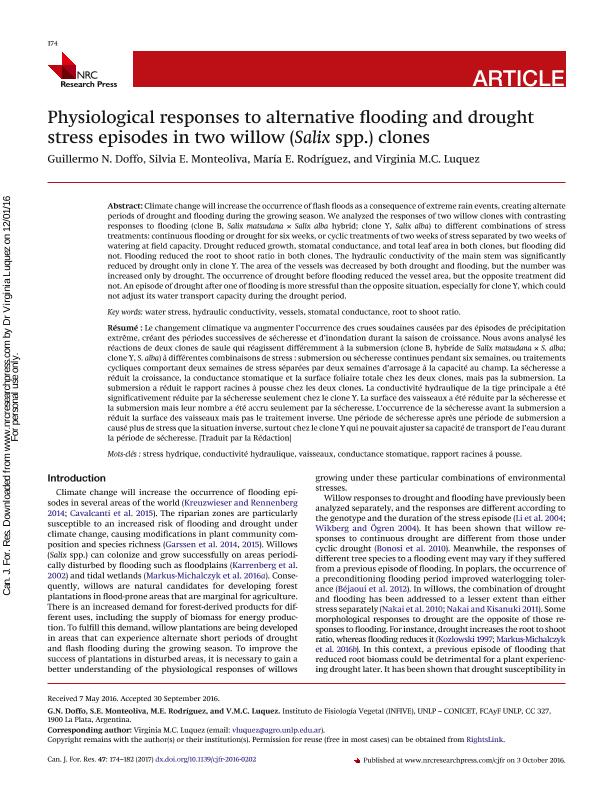Artículo
Physiological responses to alternative flooding and drought stress episodes in two willow (Salix spp.) clones
Doffo, Guillermo Nestor ; Monteoliva, Silvia Estela
; Monteoliva, Silvia Estela ; Rodriguez, Maria Eugenia; Luquez, Virginia Martha Cristina
; Rodriguez, Maria Eugenia; Luquez, Virginia Martha Cristina
 ; Monteoliva, Silvia Estela
; Monteoliva, Silvia Estela ; Rodriguez, Maria Eugenia; Luquez, Virginia Martha Cristina
; Rodriguez, Maria Eugenia; Luquez, Virginia Martha Cristina
Fecha de publicación:
01/2017
Editorial:
National Research Council Canada-NRC Research Press
Revista:
Canadian Journal Of Forest Research
ISSN:
0045-5067
Idioma:
Inglés
Tipo de recurso:
Artículo publicado
Clasificación temática:
Resumen
Climate change will increase the occurrence of flash floods as a consequence of extreme rain events, creating alternate periods of drought and flooding during the growing season. We analyzed the responses of two willow clones with contrasting responses to flooding (clone B, Salix matsudana × Salix alba hybrid; clone Y, Salix alba) to different combinations of stress treatments: continuous flooding or drought for six weeks, or cyclic treatments of two weeks of stress separated by two weeks of watering at field capacity. Drought reduced growth, stomatal conductance, and total leaf area in both clones, but flooding did not. Flooding reduced the root to shoot ratio in both clones. The hydraulic conductivity of the main stem was significantly reduced by drought only in clone Y. The area of the vessels was decreased by both drought and flooding, but the number was increased only by drought. The occurrence of drought before flooding reduced the vessel area, but the opposite treatment did not. An episode of drought after one of flooding is more stressful than the opposite situation, especially for clone Y, which could not adjust its water transport capacity during the drought period.
Archivos asociados
Licencia
Identificadores
Colecciones
Articulos(INFIVE)
Articulos de INST.DE FISIOLOGIA VEGETAL
Articulos de INST.DE FISIOLOGIA VEGETAL
Citación
Doffo, Guillermo Nestor; Monteoliva, Silvia Estela; Rodriguez, Maria Eugenia; Luquez, Virginia Martha Cristina; Physiological responses to alternative flooding and drought stress episodes in two willow (Salix spp.) clones; National Research Council Canada-NRC Research Press; Canadian Journal Of Forest Research; 47; 2; 1-2017; 174-182
Compartir
Altmétricas



